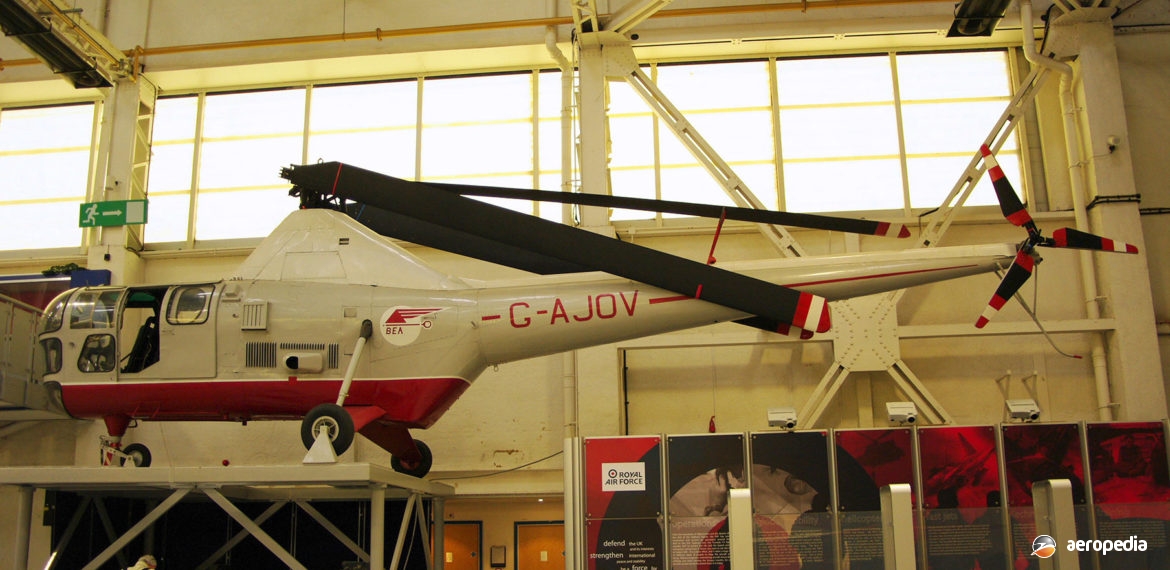Photograph:
Westland Dragonfly HR.3 WP495/ G-AJOV at Cosford, United Kingdom in July 2012 (David C Eyre)
Country of origin:
United Kingdom
Description:
General utility helicopter
Power Plant:
One 410 kw (550 hp) Alvis Leonides 521/1 nine-cylinder air-cooled radial engine
Specifications:
- Rotor diameter: 14.93 m (49 ft)
- Length: 12.49 m (41 ft)
- Height: 3.96 m (12 ft 11½ in)
- Max speed at sea level: 153 km/h (95 mph)
- Cruising speed: 137 km/h (85 mph)
- Inclined climb rate at sea level: 305 m/min (1,000 ft/min)
- Service ceiling: 4,023 m (13,200 ft)
- Hovering ceiling in ground effect: 2,134 m (7,000 ft)
- Hovering ceiling out of ground effect: 1,829 m (6,000 ft)
- Range: 483 km (300 miles)
- Empty weight: 1,980 kg (4,366 lb)
- Loaded weight: 2,586 kg (5,700 lb)
History:
In 1947 Westland Aircraft Co obtained a licence to build the Sikorsky S-51 in the United Kingdom for the British military services, this being a four-seat general purpose helicopter in service with the USAAF at that time. Some changes were made to meet British construction methods, and an Alvis Leonides engine was installed in lieu of the Pratt & Whitney R-985 radial engine, the name Dragonfly being given to the new type.
The majority constructed were for the Royal Navy and Royal Air Force, a total of 139 being completed in a number of variants, the HR Mk 1 and Mk 3 for the Royal Navy, the latter having all-metal rotor blades and hydraulic servo control mechanism; and the HC Mk 2 and Mk 4 for the RAF. In addition, two variants were produced for civil use, these being the Mk 1A with the Alvis Leonides 521/1 engine, and the Mk 1B with the Pratt & Whitney R-985 engine. A couple were exported to the Yugoslavian Air Force.
The first British-built machine flew in 1948, this being for a civil operator, and was followed by the first for the RAF, an HC Mk 2 (WF308). The first HC Mk 4 (WT845) entered service in 1952, the RAF aircraft being fitted out for casualty evacuation with one stretcher in an enclosed pannier on each side of the fuselage. In August 1950 the RAF formed the Casualty Evacuation Flight and some aircraft were sent to operate in the rescue role in Malaya, this unit later being expanded to form No 194 Squadron on 1 February 1953. They remained with the Far East Air Force until 1956.
The first machine for the Royal Navy was the HR Mk I which had a three-blade rotor of composite construction and was equipped for the general utility role. The main variant supplied was the HR Mk 3 with a three-blade metal rotor and hydraulic servo-control mechanism, the last of this model (WP504) being delivered on 28 September 1953. Royal Navy machines also saw service in civilian rescue work, and in June 1953 twelve were flown in formation during the Royal Navy Coronation Review at Spithead in Hampshire.
Four examples of the Dragonfly were loaned to the Royal Australian Navy by the Royal Navy, the first being an HR 1 serial VZ965 which was operated for a period from 29 October 1951 on board the aircraft carrier HMAS Sydney. The other three were all HR 3s and were serials WG707, WG753 and WP498 which also operated for short periods from the RAN aircraft carrier mainly on rescue duties.
In April 2000 the Australian Museum of Flight (formerly Australian Naval Aviation Museum) at HMAS Albatross, Nowra, NSW received a Westland Dragonfly HR 3 (serial WG725) from the United Kingdom for display. Built in 1952, it spent some time with the RAF Museum Collection until sold in 1981. It was made airworthy in 1982 and received an American registration (N9987Q), but was not delivered to the United States. This machine had previously been in a theme park at RNAS Station Culdrose in Cornwall and was rescued. It was displayed (painted as WG754 / 912) in 1986 at the Flambards Triple Theme Park, Helston, also in Cornwall, until shipped to Australia where it is on display in an unrestored state at Nowra.

